Tomato “Early Love” that looks and tastes perfect: we grow it correctly and set yield records
In ancient times, tomatoes were grown exclusively for decoration; people considered the vegetable decorative. Centuries later, tomatoes turned from decorations into a tasty and healthy product. Nowadays, summer residents are striving to plant the juiciest and most unpretentious varieties on their plots. One of these is a tomato called Early Love.
It is attractive to gardeners who spend a minimum of time caring for tomatoes. The plant does not need staking or pinching, which greatly simplifies its cultivation. Let us further consider why tomatoes deserve such a gentle and romantic name, and also reveal the secrets of its cultivation.
Description of the variety
The bushes are determinant and have limited growth. The average height of one is about 90 cm. In greenhouse conditions, the figures increase to 2 m. The leaves are similar to potato foliage, medium in size, light green in color. Early love is unpretentious in care and shows good yield indicators.
Distinctive features
The name of the variety speaks for itself: the ripening time of tomatoes is only about 90 days. Tomatoes on clusters set quickly. To get the maximum amount of juicy and ripe tomatoes, the variety is grown mainly in the southern regions of the country. In areas with more severe climatic conditions, the variety is planted in a greenhouse or greenhouse.
Characteristics of tomatoes and yield
Raspberry or red tomatoes have soft and juicy flesh.The weight is small, about 70-100 g. The shape is round, slightly elongated, and has slight ribbing. The skin is dense and velvety. 4-6 tomatoes are tied on one brush at the same time. The yield is average: about 2 kg of tomatoes are harvested from one bush.
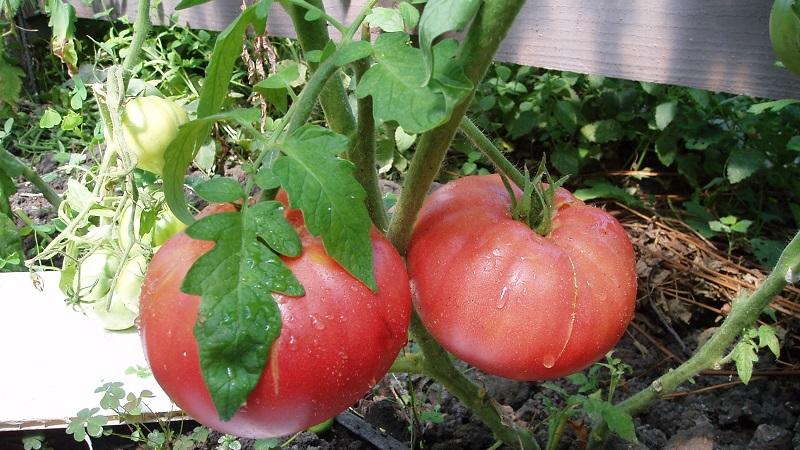
How to grow seedlings
Experienced gardeners recommend planting the Early Love tomato in seedlings. This makes it easier for vegetables to take root in the soil and get used to a certain climate. Seedlings are prepared 55-60 days before planting in the ground. You will need soil, a container, seeds, as well as a disinfectant solution and growth stimulants.
Seed preparation
Before planting, the seeds are disinfected and germinated. To disinfect, place them in a cloth bag and soak them in a hydrogen peroxide solution. It will destroy all germs and dangerous bacteria on the surface of the seed. Germination involves placing the treated seeds in slightly damp gauze and placing them in a plate with a small amount of water.
Germination helps the first shoots sprout faster and develop immunity against possible diseases. In addition, this is how gardeners check the quality of the material and the percentage of overall germination. For the most powerful effect, add growth stimulants to the water: the most common of them are “Zircon”, “Silk”, “Epin-extra”.
Important! Aloe juice serves as an organic supplement. The seeds are dipped in juice in a fabric bag and then dried to a loose state. Aloe juice increases the overall germination of seeds by up to 25%.
Container and soil
The soil for seedlings must be nutritious and contain the vitamins necessary for the plant. It is recommended to purchase ready-made soil for seedlings in the store, since the manufacturer will comply with all norms and requirements.But some go the other way and prepare the ground on their own. 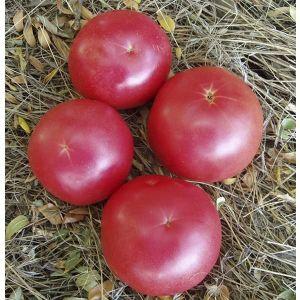
For this use:
- soil from the garden;
- humus;
- sawdust;
- peat.
These elements are mixed in a ratio of 4:1:1:1 and placed in the freezer for a day. The cold will kill larvae and pathogens.
After hardening, the soil is taken out and poured into containers for seedlings: plastic cassettes, peat pots, flower pots. All this is sold in gardening stores.
However, to avoid unnecessary expenses, many gardeners use ordinary plastic jars of sour cream or mayonnaise for seedlings. The main thing is to wash them thoroughly, dry them and make small holes at the bottom through which excess water will flow out when watering.
Sowing
Add soil to the container and make small grooves. The ideal distance between them is about 3 cm. Sprouted seeds are placed in the holes, covered with soil on top and thoroughly watered with settled warm water.
It is recommended to cover the top of the seedlings with plastic film or a lid, which is removed only after the first shoots appear.
Growing and care
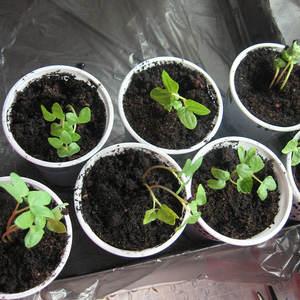 Place the seedlings in the warmest and brightest place in the house. If this is a windowsill, then be careful not to allow drafts. Plants should receive at least 15 hours of sunlight per day. If there is less daylight in your region, arrange additional lighting using lamps.
Place the seedlings in the warmest and brightest place in the house. If this is a windowsill, then be careful not to allow drafts. Plants should receive at least 15 hours of sunlight per day. If there is less daylight in your region, arrange additional lighting using lamps.
The first watering is carried out on the 10th day after planting. Never water the sprouts with cold tap water. Also try to ensure that the water gets mainly under the root, and not on the leaves and stem. To do this, use a pipette or syringe.
The Early Love variety loves feeding, so organize the first one after 15 days.A solution based on onion peels or wood ash is excellent for this. In the future, fertilizing is carried out regularly before planting. seedlings into the ground.
How to grow tomatoes
The process of growing the variety is simple and does not require special knowledge and skills. A huge advantage of Early Love is that the tomato does not form stepsons and does not need garters. Let us consider further what exactly is needed to obtain a good harvest.
Landing
Tomatoes are planted only in beds prepared in advance. Choose the lightest and warmest area in your garden for the vegetable. Dig it up, remove all debris, and water it with a solution of potassium permanganate. This will disinfect the soil.
Tomatoes are planted in beds, leaving a distance of about 50 cm between the bushes. If the planting is done more densely, the tomatoes will not have enough space for root development and nutrition. The sprouts are transferred to the soil with a lump of earth on the roots. Be careful not to break young and immature seedlings.
Care
Proper care is as follows:
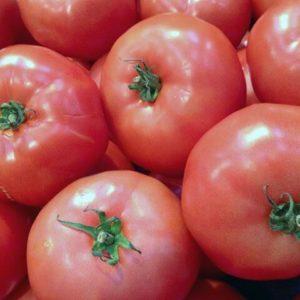 Regular watering. Carried out every 8 days. To prevent diseases, a tea-based solution or garlic mixture is sometimes added to the water. This reduces the risk of fungi and infections. It is recommended to water Early Love with rain or melt water. Do not over-moisten the soil: excess moisture leads to cracking of tomatoes and loss of taste.
Regular watering. Carried out every 8 days. To prevent diseases, a tea-based solution or garlic mixture is sometimes added to the water. This reduces the risk of fungi and infections. It is recommended to water Early Love with rain or melt water. Do not over-moisten the soil: excess moisture leads to cracking of tomatoes and loss of taste.- Weed removal. Foreign plants disrupt the metabolism in the bushes, which leads to their wilting. Especially a lot of weeds appear after rains and fogs. It is important to remove them every 7-10 days.
- Loosening the soil provides oxygen access to the plant. Sawdust or river sand are used as a natural leavening agent.
- Fertilizing bushes. Feed the bushes every 2 weeks. To do this, use nitrogen-containing preparations or organic matter. For example, ammonium nitrate or liquid bird droppings are excellent food for tomatoes.
Features and possible difficulties
When growing, gardeners are faced with some nuances. For example, an excess of nitrogen-containing fertilizers. Sometimes the desire to feed the crop leads to disastrous results.
The fact is that a large amount of nitrogen stimulates the development of green mass, which slows down the ripening of fruits. Therefore, the first fertilizing should not contain nitrogen; give preference to organic fertilizers.
In addition, never water tomatoes from above, on the leaves. This should be done at the root, and then carefully loosen the soil around the bushes. The ideal time for watering is early morning or evening. 2-3 liters of water is enough per bush. Focus on the weather: if it's a hot or rainy summer, reduce the amount of water.
Important! During the flowering period, tomatoes’ “appetite” increases sharply, so they need abundant watering based on balanced fertilizers.
Diseases and pests
Tomatoes have high immunity to diseases, but some of them still manage to “attack” Early Love.
First of all, we are talking about fungal diseases:
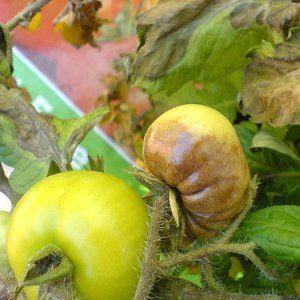 Late blight appears in the form of brown spots on the leaves and is accompanied by wilting of the bushes. To combat it, the drugs “Quadris” and “Fundazol” are used.
Late blight appears in the form of brown spots on the leaves and is accompanied by wilting of the bushes. To combat it, the drugs “Quadris” and “Fundazol” are used.- Septoria looks like white spots with a brown rim, appears as a result of improper care and high humidity. An excellent remedy for it is a solution of Bordeaux mixture.
- Alternaria blight destroys leaves, stems and fruits. Infection usually occurs through the soil.It appears in the form of small spots that increase over time.
The most common insect pests on tomatoes are spider mites and aphids. The mite entangles the leaves with a white cobweb, which causes metabolic failure in the latter.
For preventative purposes, spray the bushes with whey. Aphids are small white insects that accumulate in colonies on bushes. To prevent it, plants are sprayed with a solution of copper sulfate.
The nuances of growing in open ground and greenhouses
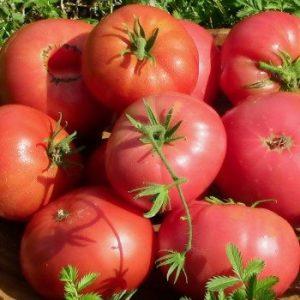 In open ground, tomatoes are grown after legumes, onions, and cucumbers. Summer residents do not recommend planting tomatoes after potatoes, eggplants or peppers. The location of the tomato bed is changed every year. Monitor the acidity of the open ground: lime will help against its excess. The rate of lime fertilizers depends on the composition of the soil.
In open ground, tomatoes are grown after legumes, onions, and cucumbers. Summer residents do not recommend planting tomatoes after potatoes, eggplants or peppers. The location of the tomato bed is changed every year. Monitor the acidity of the open ground: lime will help against its excess. The rate of lime fertilizers depends on the composition of the soil.
It is best to form the beds from east to west, so the earth will warm up faster. The holes are placed in straight rows or in a checkerboard pattern.
Before boarding to the greenhouse The beds are prepared 10 days before planting. The soil is loosened and humus is added. If the soil is infertile, then charcoal is added. Loamy or sandy loam compounds are best suited for tomatoes.
You can’t plant tomatoes in cold soil; you need to warm it up first. The optimal temperature is about 15 degrees. It is better to plant early in the morning in pre-moistened soil.
Harvesting and application
The return of Early Love is gradual, so tomatoes are harvested as they ripen. Pick carefully without damaging the stem. Make sure that the vegetables do not overripe. For storage, place in a cool place where the tomatoes “reach” the stage of 100% ripeness.
The range of uses for tomatoes is incredibly wide. The product is used in the preparation of first and second courses, side dishes and salads, appetizers, tomato juice and even desserts. For example, the well-known recipe for tomatoes in caramel with ice cream has won the hearts of many chefs.
Early love has a sweet-sour taste that harmoniously complements meat or poultry. Chefs love to use vegetables for stuffing or stewing. Many people make sun-dried tomatoes or preparations for the winter.
Advantages and disadvantages of the variety
The variety Early Love is loved by many because of its merits:
- ease of care;
- early ripeness;
- juicy taste;
- versatility in application;
- attractive appearance.
However, tomato also has a number of disadvantages:
- average yield;
- the plant is capricious to fertilizers during growth;
- in the northern regions of the country it is suitable only for greenhouse conditions or under film.
Farmer reviews
There are both positive and not so positive reviews about the Early Love variety online.
 Galina, Volgograd: “I like varieties that don’t require a lot of attention. My garden is located outside the city, I can’t go there every day. That’s why I chose the Early Love variety a couple of years ago. He did not disappoint me, the vegetables grow tasty and juicy. I especially like to preserve them for the winter.”
Galina, Volgograd: “I like varieties that don’t require a lot of attention. My garden is located outside the city, I can’t go there every day. That’s why I chose the Early Love variety a couple of years ago. He did not disappoint me, the vegetables grow tasty and juicy. I especially like to preserve them for the winter.”
Marina, Orsk: “A friend recommended this variety to me. Overall, I was pleased with the harvest, especially that the tomatoes were neat and beautiful. During the entire ripening period, I sprayed it with a whey solution, and all diseases avoided the bushes.”
Olga, Kurgan region: “I plant at least five different varieties on the plot every year. So last year the Early Love tomatoes turned out to be the worst.I waited a long time for the ovary, although the variety positions itself as early ripening. I didn’t like the taste.”
Conclusion
The name of the variety is very delicate and beautiful, as is the appearance of the tomatoes themselves. Neat, smooth, pleasant-colored tomatoes are grown not only for themselves, but also for sale.
About 2 kg of delicious and juicy fruits are collected from one bush. The vegetable is planted in seedlings; its application is universal: it is used in cooking, folk medicine and cosmetology.